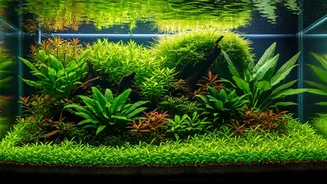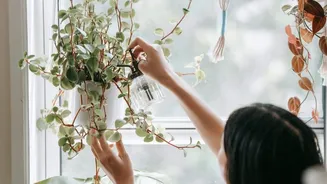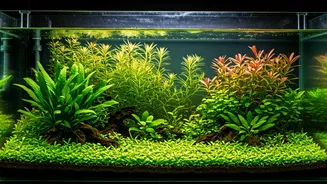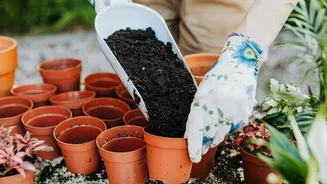Anacharis: The Beginner's Choice
Anacharis, often considered the easiest plant for beginners, is a versatile option that adapts well to various water conditions. Its rapid growth helps
consume excess nutrients, which helps to prevent algae blooms and keeps the water clean. Anacharis can be planted in the substrate or left floating, and it provides shelter for small fish and fry. This plant thrives in moderate to high light, but it can still survive in low-light environments. Regular pruning is necessary to control its growth, but its resilience makes it a great choice for establishing a balanced ecosystem from the start. Its ease of propagation also allows for the expansion of the green space within the aquarium.
Java Fern: Low-Maintenance Beauty
The Java Fern is another hardy plant known for its low maintenance requirements. It is a slow-growing plant that can thrive even without added CO2, making it suitable for beginners. Java Fern should be attached to driftwood or rocks rather than planted in the substrate because it has rhizomes that can rot if buried. It thrives in moderate to low light and prefers slightly acidic water. Providing a hiding place for fish is its secondary benefit. Different variations of Java Fern are available, and each adds a unique touch of texture and shape to the aquarium. It tolerates a range of water conditions and provides visual interest with its distinctive leaves, making it a valuable asset for any aquarium setup.
Amazon Sword: A Classic Choice
The Amazon Sword is a classic aquarium plant, appreciated for its large, lush appearance. It can grow quite large, so it needs enough space to thrive. It requires nutrient-rich substrate and moderate to high lighting to flourish. Its broad leaves create a stunning focal point, and it provides excellent shelter for larger fish species. Regularly add liquid fertilizer to feed the Amazon Sword and maintain its vibrant colors. Regular pruning of old or yellowing leaves is essential to encourage new growth and maintain the plant's health. The Amazon Sword’s visual impact and beneficial effects on the aquarium ecosystem make it a popular and beneficial addition for many aquarists.
Java Moss: Versatile and Useful
Java Moss is a versatile plant that can be used to create lush carpets, attached to décor, or allowed to float freely. It is extremely adaptable and can tolerate a wide range of water parameters and lighting conditions, making it an excellent choice for any aquarium. Java Moss provides excellent shelter for small fish, shrimp, and fry, helping to reduce stress and increase survival rates. It also helps to filter water by absorbing nitrates and other waste products. Regular trimming is necessary to prevent it from overtaking other plants. Java Moss is easy to propagate, so it can be used to expand the green space in the aquarium. Its resilience and usefulness make it a popular choice for both new and experienced aquarists.
Cryptocoryne: A Diverse Genus
Cryptocoryne, or 'Crypts,' is a diverse genus of plants with various species, each bringing its unique shape and color to the aquarium. Crypts usually grow in the substrate and are best suited to nutrient-rich substrate and low to moderate lighting. They're slow-growing and can be sensitive to sudden changes in water parameters, which can cause 'Crypt melt,' where the leaves disintegrate. Once established, they are quite easy to care for and can create a lush, textured underwater environment. There are many Crypt species, each offering unique colors and shapes, making them an excellent choice for adding diversity to the aquarium. Regular fertilization and stable water conditions help Crypts thrive.
Water Wisteria: Fast-Growing Elegance
Water Wisteria is a fast-growing plant that adds a touch of elegance to any aquarium. This plant can be planted in the substrate or allowed to float, adding versatility to your aquascape. Water Wisteria thrives in moderate to high lighting and benefits from CO2 supplementation, which helps speed up its growth and intensifies its colors. Its fast growth rate helps to consume excess nutrients, which in turn helps prevent algae growth. It also provides excellent shelter and a natural filtration system within the aquarium. Regular pruning is necessary to maintain its shape and prevent it from shading out other plants. Its speed of growth and elegant appearance make it an appealing plant for any aquarium.
Dwarf Hairgrass: Create a Lawn
Dwarf Hairgrass is a popular choice for creating a lush, grassy lawn effect in the aquarium. This plant is planted in the substrate and requires a nutrient-rich substrate, along with high lighting and CO2 supplementation to flourish. It spreads via runners, gradually forming a dense carpet of fine, grass-like blades. Regular trimming is needed to maintain the desired height and density of the lawn. It also provides a natural and visually appealing background to any aquarium landscape. The Dwarf Hairgrass is a great option for aquascaping and contributes to a visually stunning and dynamic underwater environment. The addition of this plant adds a sense of depth and realism, making your aquarium even more attractive.














